#Eastern Han Dynasty (25–220 A.D.)
Text
[Hanfu · 漢服]Chinese Eastern Han Dynasty (25–220 A.D.) Traditional Clothing Hanfu with Actor Liu Tao/刘涛


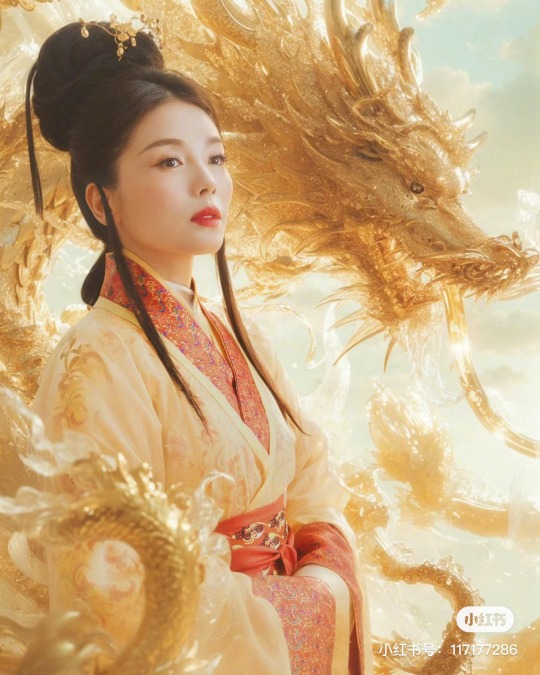
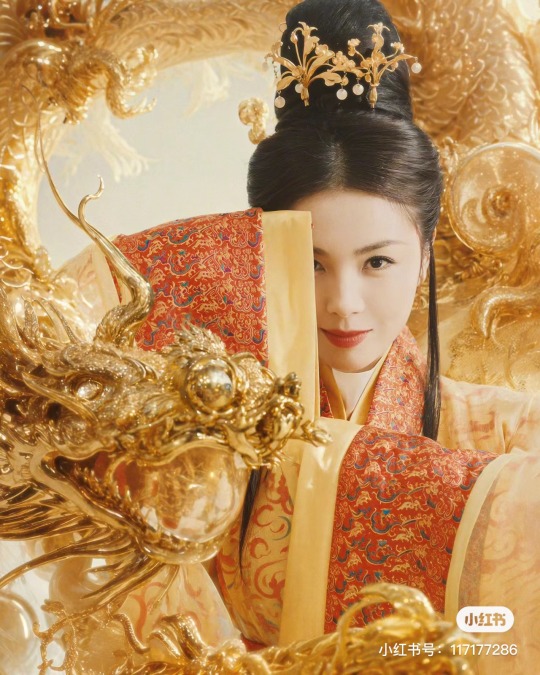



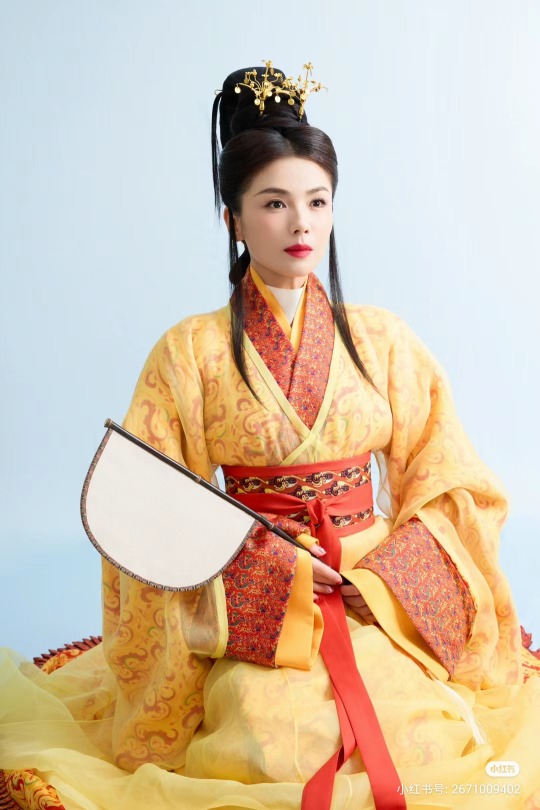

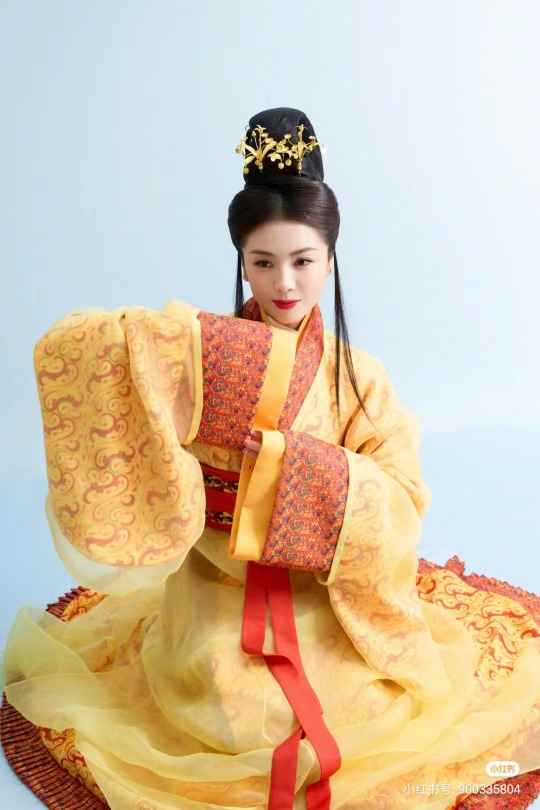

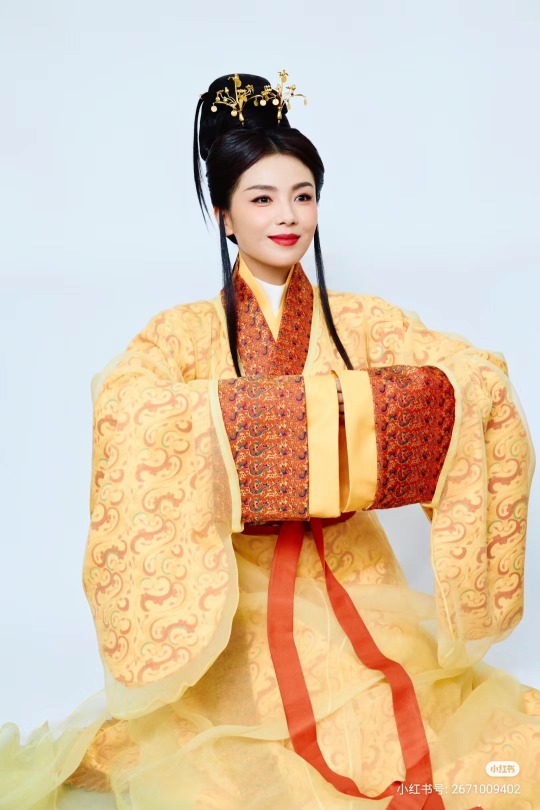
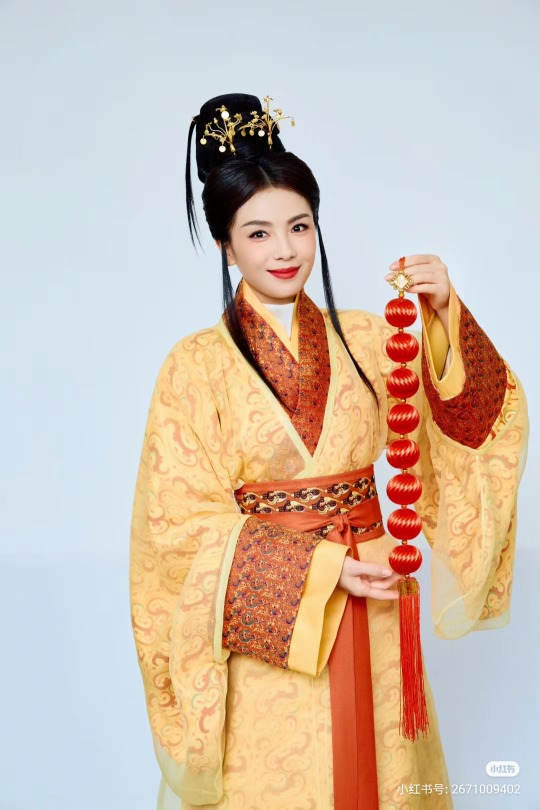


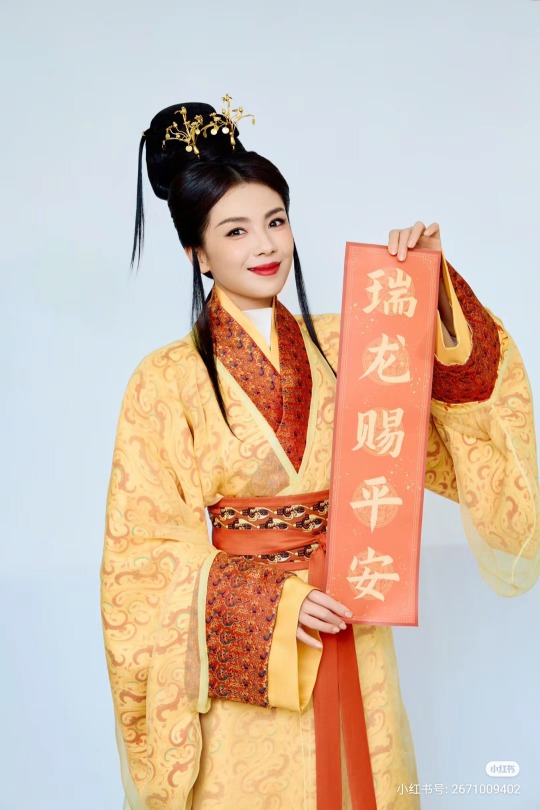
【Historical Artifacts Reference 】:
▶China Han Dynasty Murals<Part of the person holding the halberd and sword>, Luoyang Museum Collection.

▶China Jin Dynasty Painting By Gu Kaizhi (Chinese: 顧愷之,344–406)
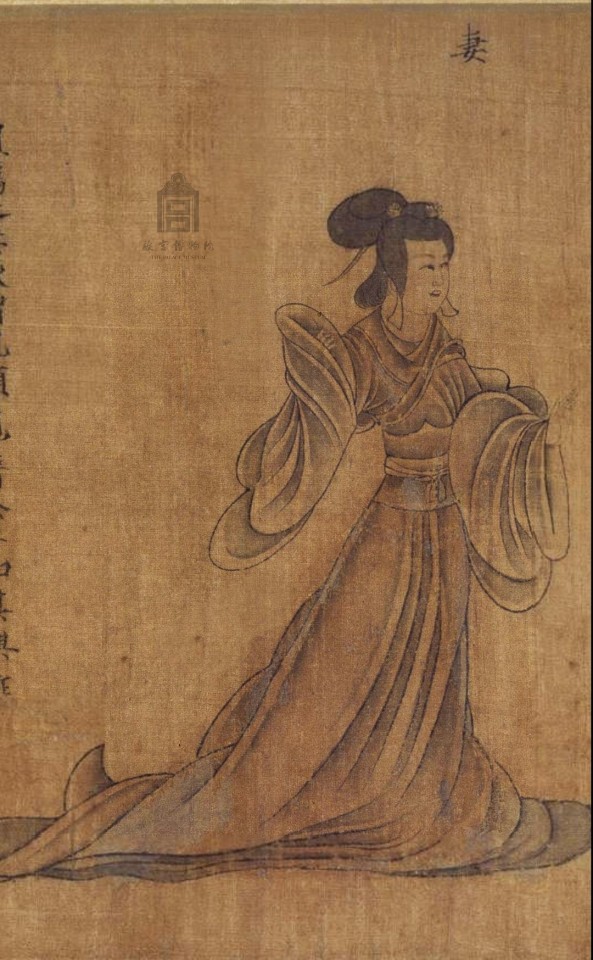

#chinese hanfu#Eastern Han Dynasty (25–220 A.D.)#hanfu#hanfu accessories#hanfu_challenge#chinese traditional clothing#china#chinese#漢服#汉服#中華風#liu tao#chinese fashion#historical fashion#historical hairstyle#chinese style
202 notes
·
View notes
Text

Pigsty with Tower
China, Eastern Han dynasty (A.D. 25–220)
134 notes
·
View notes
Photo

~ Funerary Sculpture of a Horse.
Place of origin: China, Sichuan Province
Culture: Eastern Han dynasty
Date: A.D. 25-220
Medium: Molded earthenware with modeled and carved decoration.
#ancient#ancient art#ancient sculpture#funerary sculpture of a horse#china#eastern han dynasty#a.d. 25#a.d. 220
232 notes
·
View notes
Text
Mythology behind White Snake: Afterlife and Reincarnation
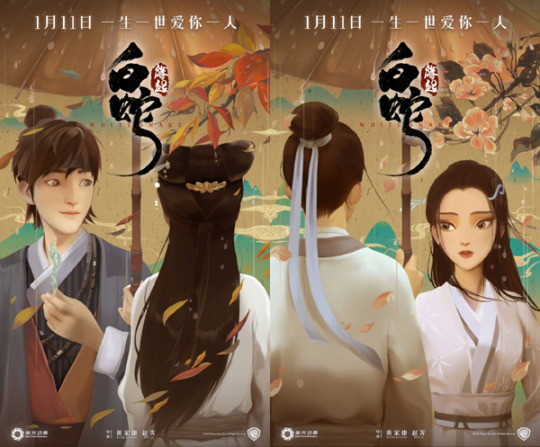
The Past Life and This Life
In fact, more than 2000 years ago, Chinese people believed that death is a one-way trip. When they died, their soul just separated from their body, and traveled to the Underworld and lived there instead. However, things changed when the idea of reincarnation was introduced along with Buddhism from ancient India to China during the Eastern Han dynasty (25 A.D.~220 A.D.).
The spread of Buddhism greatly reshaped the concepts of the Underworld and afterlife in Chinese folklore. Other native religions, such as Taoism, also absorbed the original idea of reincarnation from Buddhism and created their own version of transmigration to explain the afterlife. As the time passed by, all those things were mixed together. Eventually, during Tang dynasty (618A.D.-907A.D.) and Song dynasty (960A.D.-1279A.D.), a very complex, sometimes even paradoxical, belief system we know today took its form.
So, what is reincarnation? And how do people reincarnate?
Reincarnation means that the soul of a living being will start a new life in a different physical body after the original body biologically died.
Generally speaking, in Chinese mythology, all living beings (human, animals, plants, supernatural beings, and even deities) have their souls, and ALL souls will join the circle of reincarnation once their physical bodies die. However, since deities are immortal, their cases are a bit different. They have to separate their souls from bodies voluntarily to join the circle of reincarnation, if they want to be reborn in the mortal world.
Anyway, after a living being dies, its soul will separate from its physical body and travel to the underworld, a place is governed by a very complicated bureaucracy and ten Judges who called “阎王” (Yan-Wang, Yama, or “Kings of Underworld”). There are tons of things, such as trails and punishments, waiting for the dead in the underworld. But they are irrelevant to the topic, so let’s skip those scary parts.
Normally, most of souls will get their ticket to the afterlife assigned by the tenth Judge who is in charge of reincarnation. However, the afterlife which a soul could get largely depends on its behaviors while it was living. For example, if a human was well-behaved during the lifetime, he/she can be reborn into a good life with a long life span, otherwise, he/she can only be born into a poor life, or sometimes even be born as an animal or a plant (Don’t worry, souls of animals and plants still have their chances to be reborn as human, and it also depends on their behaviors). This might sound familiar, if you know something called “Karma” in Buddhism. Yes, as I said, this part of Chinese mythology has received a great influence from Buddhism.
Once a soul is allowed to be reborn in the mortal world, it will be sent to the last stop in the underworld — 奈河 (Nai River). It said that Nai River is the boundary between the underworld and the mortal world. Once the soul crosses it, it will be reborn in the mortal world and the new life will begin.
However, there is only one bridge on Nai River which is called 奈何桥 (Nai He Bridge, “Bridge of Resigned One”). Its name means that no matter how many regrets a soul carried or how unwilling a soul is, it has to let them go, once it is reincarnated.
To do that, before a soul crossing the bridge, it will meet an old goddess called 孟婆 (Meng Po, or “Old Lady Meng”). She will demand the soul to take a bowl of soup she cooked, the so-called 孟婆汤 (Old Lady Meng’s soup). The soup serves the same purpose as the water of Lethe in Greek mythology which will erase all memory of the dead and make them ready for reincarnation.
However, in some stories, due to mistakes or some special destinies, a soul could manage to cross the bridge without drinking the soup. Consequently, it kept all its memories in past life when it was reborn in the mortal world.
What influences does the idea of reincarnation have on Chinese mythology?
Though the idea of reincarnation was introduced by Buddhism, Chinese mythology have a slightly different opinion about it from Buddhism. While Buddhism thinks the circle of rebirths and redeaths is a suffering and the ultimate goal of reincarnation is to achieve Nirvana (the liberation from repeated rebirth), Chinese mythology prefer to consider it as a natural order and sometimes even can be a good thing. After all, if you are well-behaved during in your lifetime, you have nothing to worry about the afterlife. And if you are doing bad things, you will be punished sooner or later.
Due to this belief, destroying someone’s soul is considered to be an extremely cruel thing which means not only killing one’s life, but also destroying his/her/its opportunity to go to the afterlife. This was also why Xiao-Bai desperately want to save Xuan’s soul at the very end, even at cost of her human form. If Xuan’s soul was destroyed, he would lost his opportunity to reincarnate.
More importantly, reincarnation means that you will still have a chance to meet those who are important to you again after you and/or they die. Even though reincarnation will erase all your memories, Chinese mythology believes that some strong bonds between souls can still be passed down form one life to another without memories, such as love, family relationship, friendship, hatred, sometimes even financial debts.
The so-called 前世姻缘(Love from a past life) commonly mentioned in traditional romance stories is a good example of this belief. In those stories, people who were married couples, or in love but couldn’t be together, in a past life would often fell in love without particular reasons when they met in another life. Similarly, love at first sight sometimes were also interpreted as an “inherited” love from a past life. Just like the last scene in White Snake movie, the reincarnated Xuan told Xiao-Bai that she looked very familiar which means that his soul still kept the love for Xiao-Bai, even though all his memories were lost.
224 notes
·
View notes
Photo


Animal pen with figures. Chinese, Han Dynasty, 1st to early 3rd century A.D. Earthenware with green lead glaze. Metropolitan Museum of Art.
From the Met:
This animal pen is populated with goats, tended to with one hand by a mother who cradles an infant in her other arm. It is typical of mingqi or "spirit utensils" that accompanied the deceased in burials of the Eastern Han dynasty (25–220 A.D.). Replicas of farm animals, utilitarian objects, and entertainers were believed to provide nourishment and amusement for the soul of the tomb occupant. The elevated structure serves as an architectural record of rustic buildings that would have been part of a large agricultural estate, and preserves in clay details of wooden design and construction—such as the low-pitched roof with a series of wood rafters flanging from a central beam—that have long since disintegrated above ground.
The popularization of mingqi over the course of the Han dynasty (206 B.C.–220 A.D.) reflects dramatic changes in Chinese society, illustrating how power circulated beyond the imperial government and nobility to a broader bureaucratic class. In the early years of the Han, Confucianism emerged as the dominant philosophy and the empire became dependent on a class of scholar-officials. They desired gratification for themselves and their families in the afterlife and plentiful clay, fashioned into models ranging from crude earthenware to fine glazed stoneware, was the ideal medium for furnishing mingqi in burials across a swath of social strata.
#Chinese art#Asian art#Han Dynasty#art history#funerary art#funerary sculpture#sculpture#ceramics#earthernware#lead glaze#minggi#Confucianism#Metropolitan Museum of Art
9 notes
·
View notes
Text
Ruins of 2,000-year-old city discovered in China
HOHHOT, Feb. 22 (Xinhua) -- Archaeologists have discovered the ruins of an ancient city in north China's Inner Mongolia Autonomous Region, believed to have been built some 2,000 years ago.
The ruins are on Deling Mountain in western Inner Mongolia, 1.3 km northwest of a section of the Great Wall constructed in the Eastern Han Dynasty (25 A.D. to 220 A.D.).
Archeologists believe that the city was built by the rulers of the dynasty to house captured troops of the South Xiongnu, an ancient ethnic group.
The city, covering about 210 hectares, has a rampart 5,850 meters long and a moat outside the city walls. Read more.
105 notes
·
View notes
Text
Inscription Leads Archaeologists to Tomb of One of the Last Han Emperors
https://sciencespies.com/history/inscription-leads-archaeologists-to-tomb-of-one-of-the-last-han-emperors/
Inscription Leads Archaeologists to Tomb of One of the Last Han Emperors
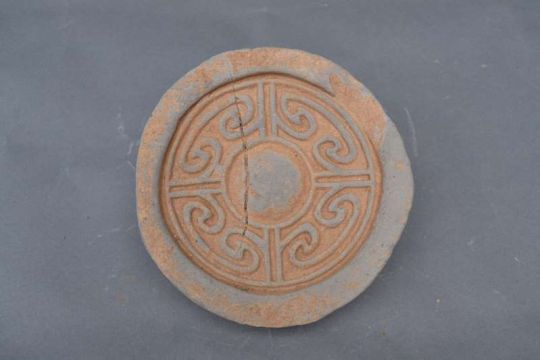
Archaeologists say the remains of a stone vessel found in a mausoleum in China’s Henan Province offer near-definitive evidence that second-century A.D. emperor Liu Zhi, known posthumously as Huan, was buried there.
“Together with the previous documents about the location of the emperor’s tomb, the discovery makes us almost certain that it is the tomb of emperor Liu Zhi,” Wang Xianqiu, who led the excavation project, tells Lyu Qiuping, Gui Juan and Shi Linjing of state-run news agency Xinhua.
Researchers had previously guessed that the tomb, located in the city of Luoyang, belonged to the Han dynasty emperor. An inscription on the vessel dating its year of manufacture to 180 A.D. appears to confirm this suspicion. Wang, a scholar at the Luoyang City Cultural Relics and Archaeology Research Institute, says the vessel was produced around the time when Liu Zhi’s successor, Liu Hong, or Ling, was building a mausoleum for the deceased emperor. The artifact is shaped like a basin and stands about ten inches tall, with a circumference of more than two feet.
Liu Zhi ruled China from 146 to 168. He took the throne as a teenager, with Empress-Dowager Liang Na and her brother Liang Ji acting as his regents. Later, after Liang Na’s death in 150, he allied with a powerful bloc of eunuchs at the court to kill Liang Ji and consolidate power. As Mark Cartwright explains for Ancient History Encyclopedia, eunuchs—typically individuals taken from border territories, castrated and enslaved in the royal household—held favored positions at Chinese court, as their lack of family ties ostensibly endeared them to the emperor. In practice, however, eunuchs often used their proximity to the ruler to gain political influence.

Archaeologists have been exploring the cemetery site since 2017.
(Luoyang City Cultural Relics and Archaeology Research Institute)
Per Week in China, Liu Zhi’s empowerment of the eunuchs contributed to the gradual fragmentation of the Chinese empire by alienating his elite courtiers. As 11th-century chronicler Sima Guang wrote in an essay later translated by historian Rafe de Crespigny, “[T]he ruinous disorder inherited by Emperors Huan and Ling was compounded by their own stupid tyranny.” Plagued by instability and corrupt leadership, the Han dynasty collapsed in 220. Following the empire’s demise, China split into three warring states known as the Three Kingdoms.
As the History Blog notes, Luoyang, located on the shores of the Luo River, was the capital of the Eastern Han dynasty for almost 200 years. Its establishment in 25 A.D. marked a shift from the Western to Eastern Han period, and the city remained the seat of power until the dynasty’s collapse in 220.
Since 2017, researchers have found more than 100 tombs at a cemetery in the city’s Baicaopo Village. The mausoleum, located at the northeast corner of the cemetery, is a large complex that includes homes. Ancient literature suggests that the burial grounds’ administrators, guards, low-ranking concubines and other workers lived at the site, perhaps alongside nobles tasked with keeping vigil over the emperor’s tomb. The tomb itself was buried in an underground “palace for the dead,” per the History Blog.
Wang tells Xinhua that the discovery of the inscribed vessel contributes to scholars’ understanding of how burials were conducted for emperors in the Eastern Han dynasty. In addition to the vessel, excavations have revealed structural elements of the tomb, including a corridor, a well and drainage channels.
Like this article?
SIGN UP for our newsletter
#History
0 notes
Text
[Hanfu · 漢服]Chinese Eastern Han Dynasty (25–220 A.D.) Traditional Clothing Hanfu Photoshoot<神女之江/River of Goddess>
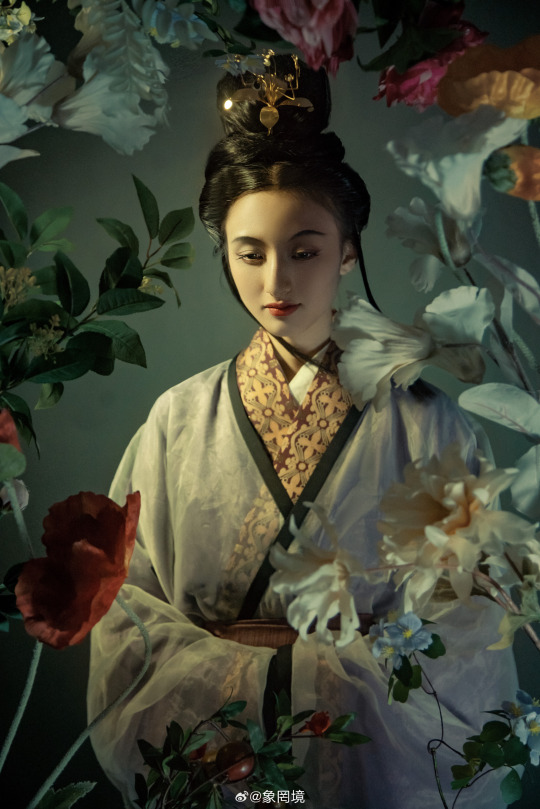

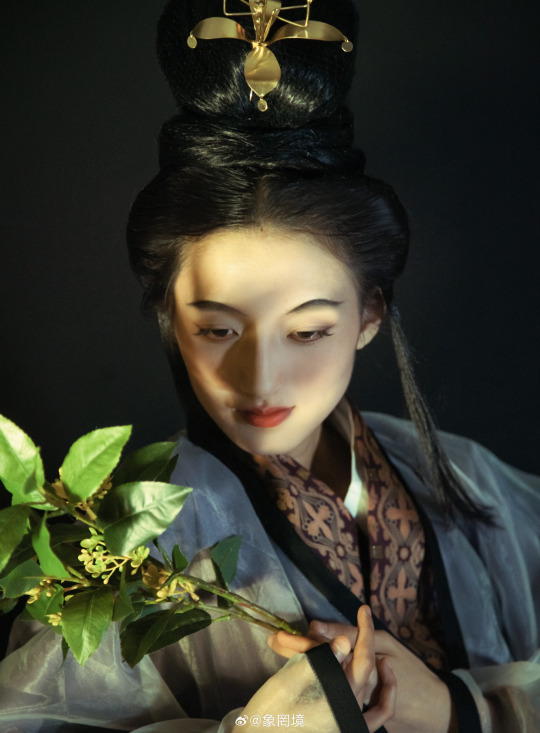






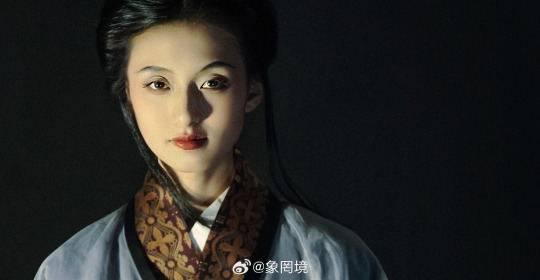

________________
📸Photo:@象罔境
🙋♂️Model:乐子
🔗Weibo:https://weibo.com/2825602213/NCohBj9nd
________________
#chinese hanfu#Eastern Han Dynasty (25–220 A.D.)#hanfu#hanfu accessories#hanfu_challenge#china#chinese traditional clothing#chinese#漢服#汉服#中華風#china history#historical fashion#象罔境
163 notes
·
View notes
Text
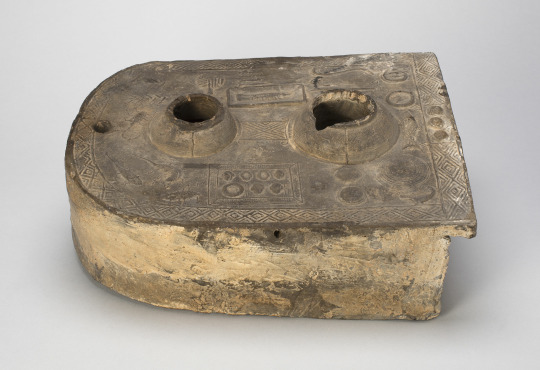
Stove
China, Eastern Han dynasty (A.D. 25–220)
Under Han rule, tombs came to represent earthly dwellings whose furnishings illuminate many aspects of domestic life. Burial models of stoves may have carried additional significance, as offerings were made to the hearth god during seasonal rites and festivities. This model is particularly well equipped. One end shows a fire door; the top has holes for caldrons or steamers and molded decoration of seafood, dishes, and cooking utensils—trays, bowls, eared cups, and skewers.
54 notes
·
View notes
Text
History of Chinese Lanterns
“Now a symbol of Chinese culture worldwide, China’s signature lanterns come from humble beginnings. Though the lanterns now are made in elaborate forms, from floating beauties to zodiac animals, their original purpose was simply to be a light source. The people of the ancient Eastern Han Dynasty (25-220 A.D.) would surround a candle with a bamboo, wood, or wheat-straw frame and stretch silk or paper over it so that the flame wouldn’t be blown out by the wind. Often, the lantern covers would be decorated with several characters, advertising the way to a shop or other establishment.
Soon, the lanterns were adopted by Buddhist monks as part of a their ritual worship on the fifteenth day of the first month of the lunar calendar. At the behest of a particularly devout emperor (Han Mingdi or Han Wudi, the name is not certain), other people joined in the ritual, lighting lanterns in reverence to the Buddha and carrying them to the palace in Luoyang.
During the Tang Dynasty, this practice had turned into a full-fledged festival, one that is still celebrated each year. On the fifteenth day of the lunar calendar, the Chinese celebrate with the Lantern Festival. The day is considered to be the end of the Chinese New Year and culminates in lantern lighting and viewing; and celebrations with family.
There are several different kinds of Chinese lanterns. The most basic form is known as the Tomato Light, which is what most people around the world associate with Chinese lanterns. More often than not, the Tomato Light is red, a color which symbolizes prosperity in Chinese culture.
The second form is called Crystal Magic. This type can be made in any geometric form, from square to hexagonal, and everything in between. Crystal Magic lanterns are typically ornately decorated, reminding viewers of one of their original purposes as palace lanterns.
The third most common type of Chinese lantern is what you might see in large lantern festivals and parades across China, like the one in Shanghai’s Yu Gardens. This type, called Buddha’s Gastronomy, has no limits to its form, growing more elaborate with each passing year.”
(Source: https://theculturetrip.com/asia/china/articles/brief-history-chinese-lanterns/)
0 notes
Photo


Nephrite Jade Pendant/Figurine in the Form of a Tapir
China, Eastern Han Dynasty, 25~220 A.D.
Animal-shaped jade pendants were commonly worn in the Han Dynasty as protective amulets to ward off evil. This artifact is in private ownership and is estimated to be worth over $145,000.
356 notes
·
View notes
Text
[Hanfu · 漢服]Chinese Eastern Han Dynasty (25–220 A.D.) Hanfu-Military Officials Hanfu Based On Han Dynasty Relics


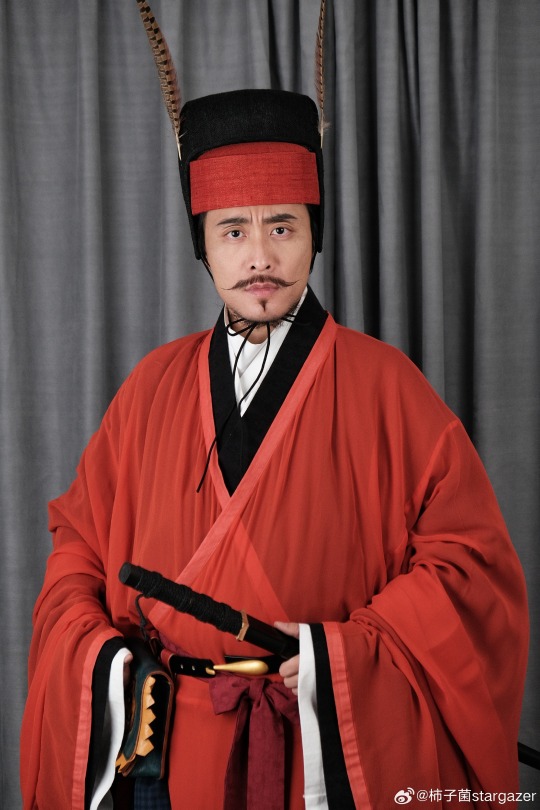


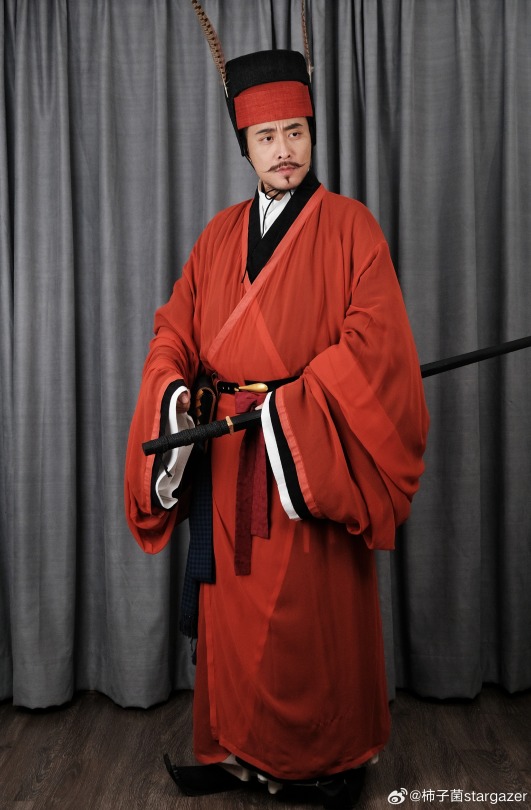

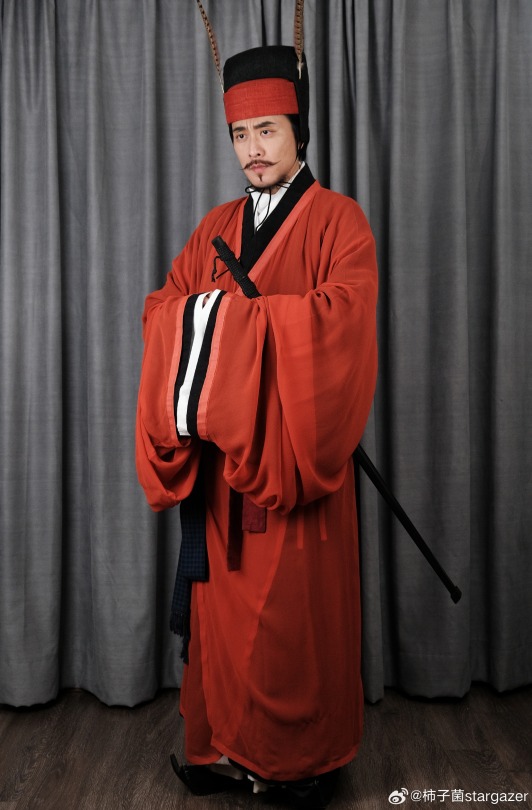
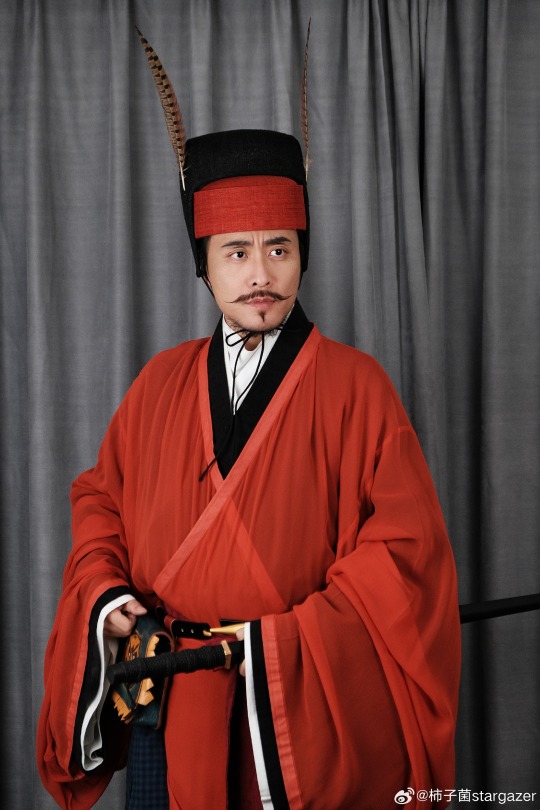
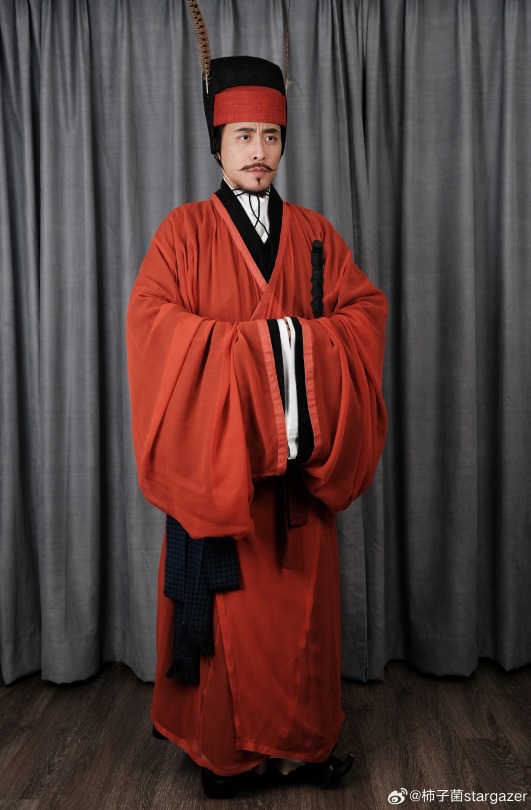
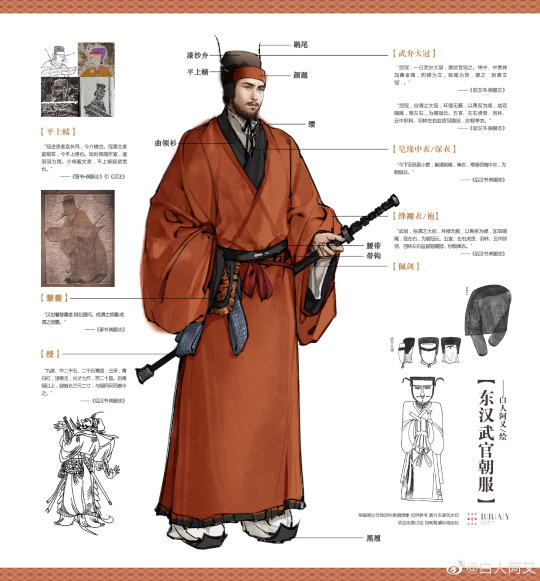
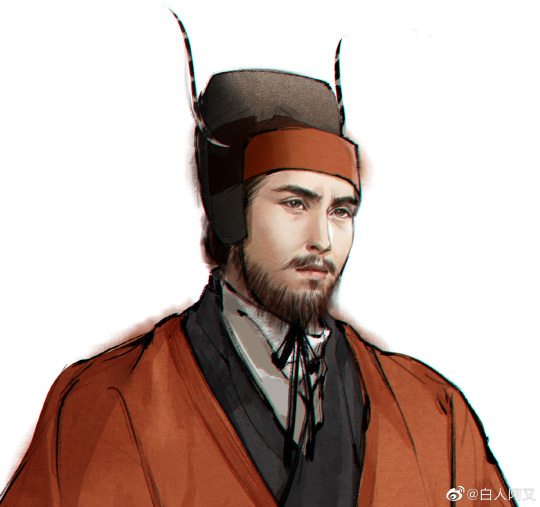
【Historical Reference Artifacts】:
Refer to the picture below to distinguish between 【civil officials(Black)】 and 【military officials(Red)】 in the Eastern Han Dynasty
Civil Officials[Black]:Murals from the Zhucun tomb in Luoyang, Henan/ 東漢晚期河南洛陽朱村墓室壁畫
For information about Eastern Han Dynasty civil servants, please refer to the following link:
https://chinesehanfu.tumblr.com/post/718472603917025280/reference-artifacts-chinese-western-han
Military Officials[Red]:Portrait bricks in Beizhai, Yinan, Shandong/山東沂南北寨東漢畫像磚
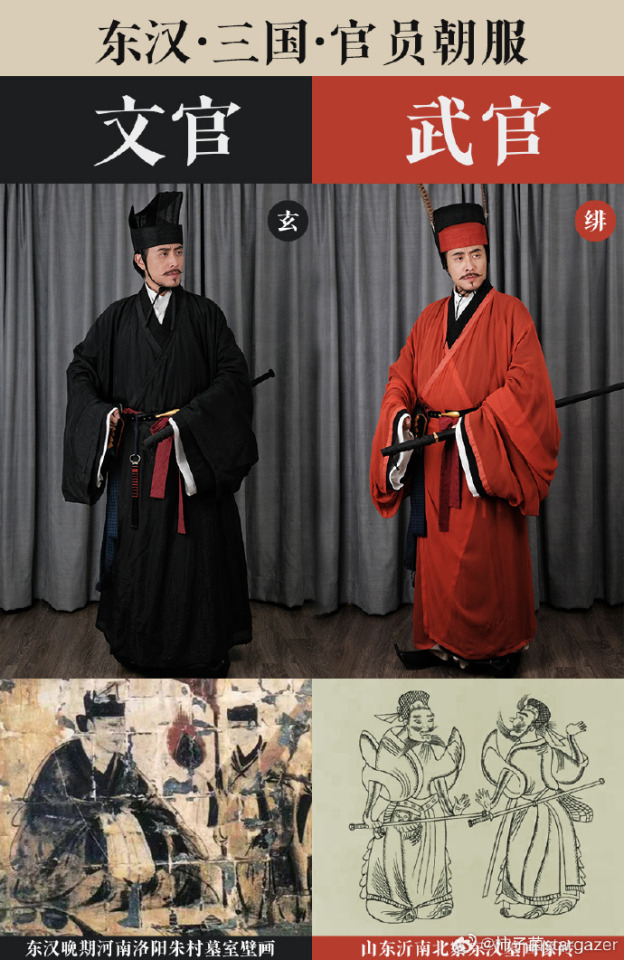

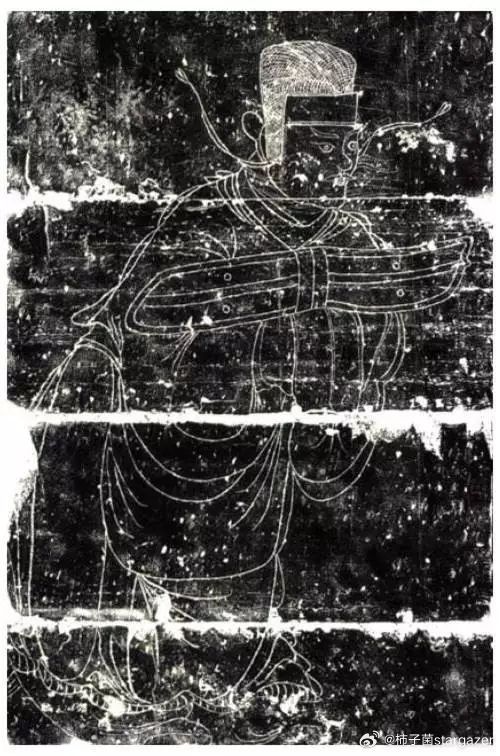

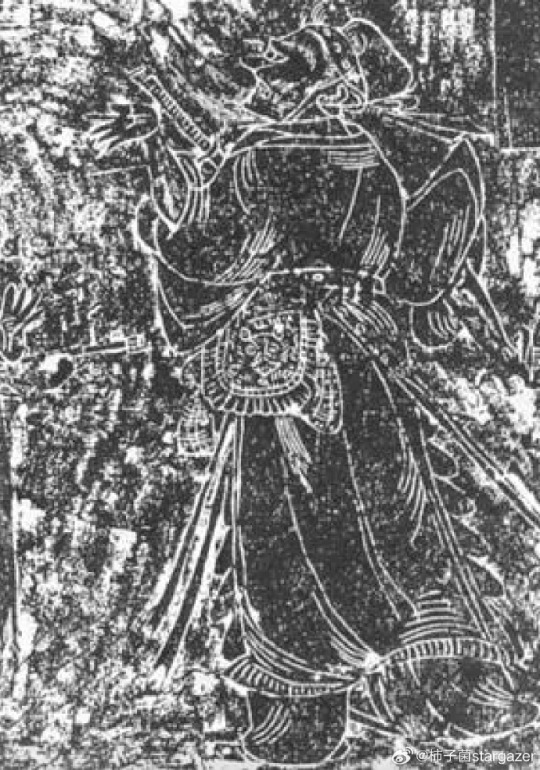
Eastern Han Dynasty- Stone figure holding a shield in the pavilion,Beijing Stone Carving Museum.
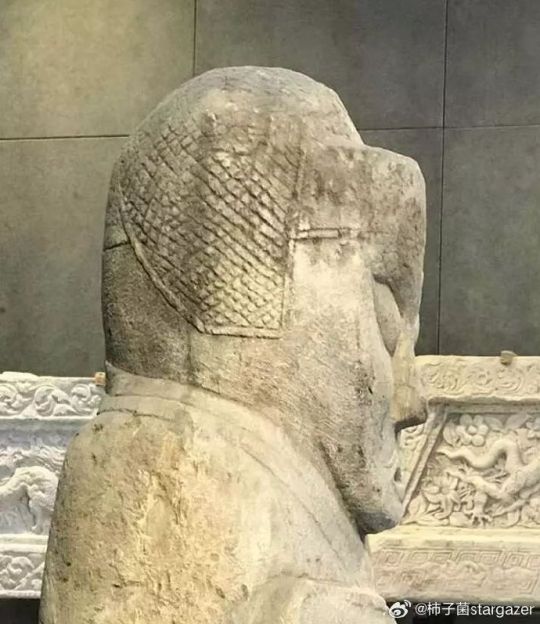

【History Note】
【武弁大冠Wubian Daguan/Military Officials Crown】
Also known as Wu Guan, He Guan, 鶡冠,鶡(pronounce:hé) is a warrior crown with "tail-feather of a brown longtailed pheasant". It was the crown of warriors from the Qin and Han Dynasties to the Sui and Tang Dynasties. During the development process, the shape of the crown changed with different periods.
※鶡(pronounce:hé):Crossoptilon mantchuricum,a bird that resembles a pheasant and is good at fighting,is one of the rare endemic animals of China
A military officials crown was unearthed from Xinmang Tomb No. 62, Mozuizi, Wuwei, Gansu Province. The crown was wrapped with thin bamboo tendons, supported by a bamboo ring on the top of the head, and lined with a bow. It is a complete example of what a military officials wore.
________________
🙋♂️Model & Recreation Work:@柿子菌stargazer
📸Photo: @张宇莹-小花
🎨Illustration Artist:@白人阿又
🔗Weibo:https://weibo.com/1812652835/NtJb89gIi
________________
#chinese hanfu#Eastern Han Dynasty (25–220 A.D.)#Military Officials#hanfu#hanfu accessories#hanfu_challenge#chinese traditional clothing#china#chinese#hanfu history#china history#historical fashion#chinese history#hanfu man#hanfu illustration#chinese fashion#漢服#汉服#chinese style
106 notes
·
View notes
Photo

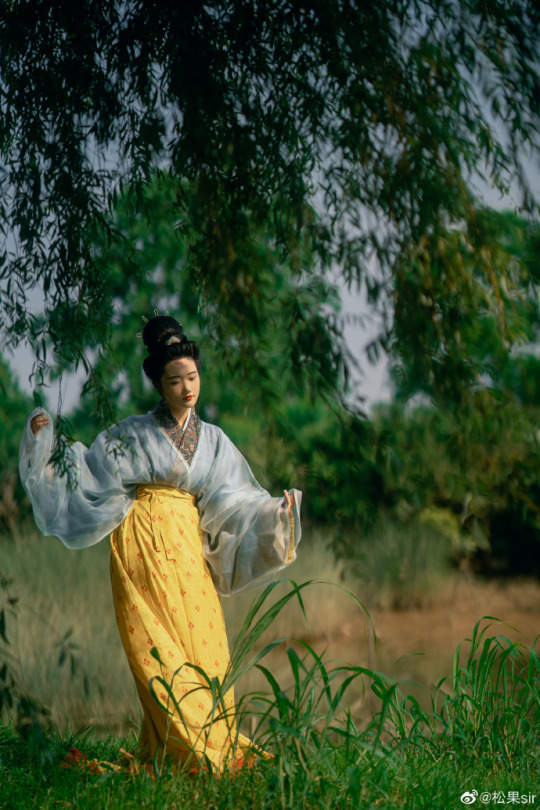
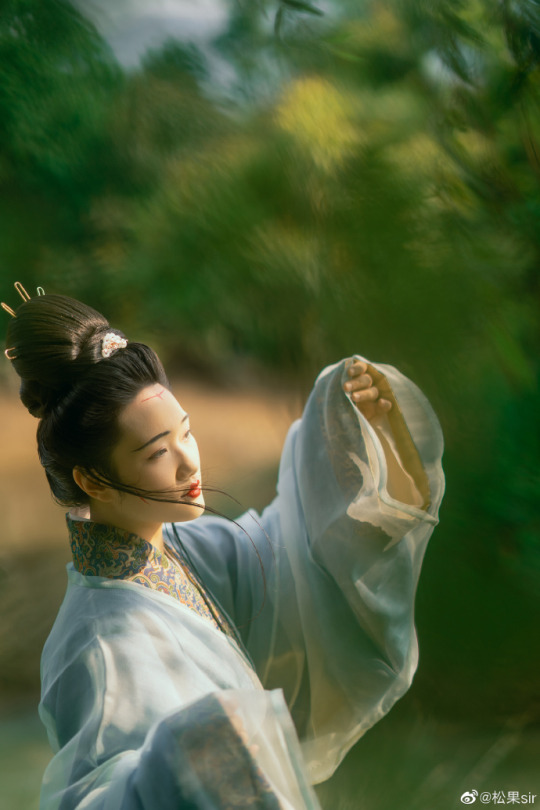
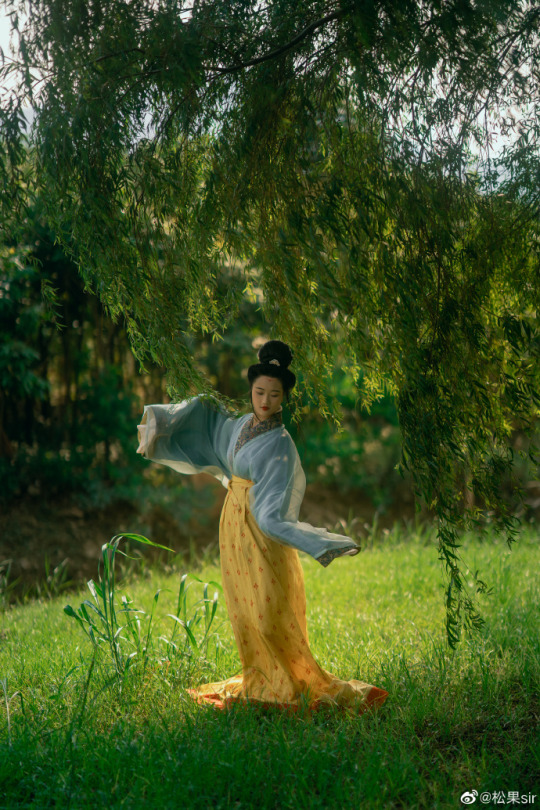

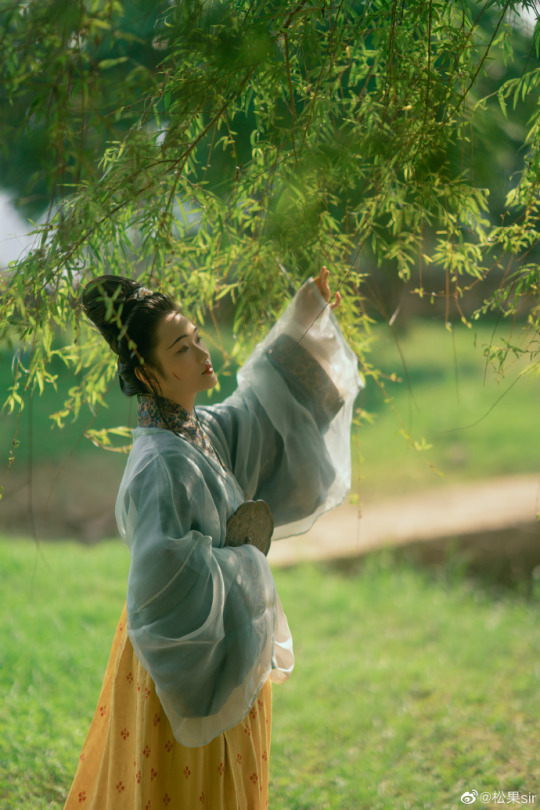
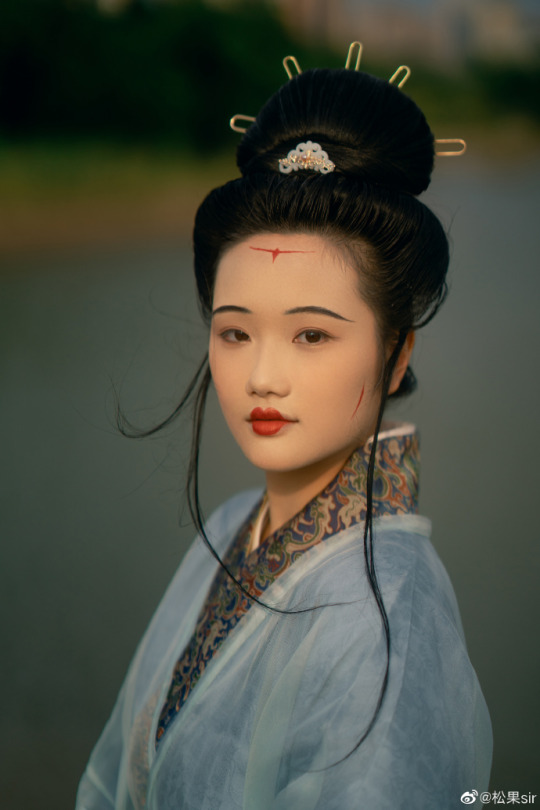

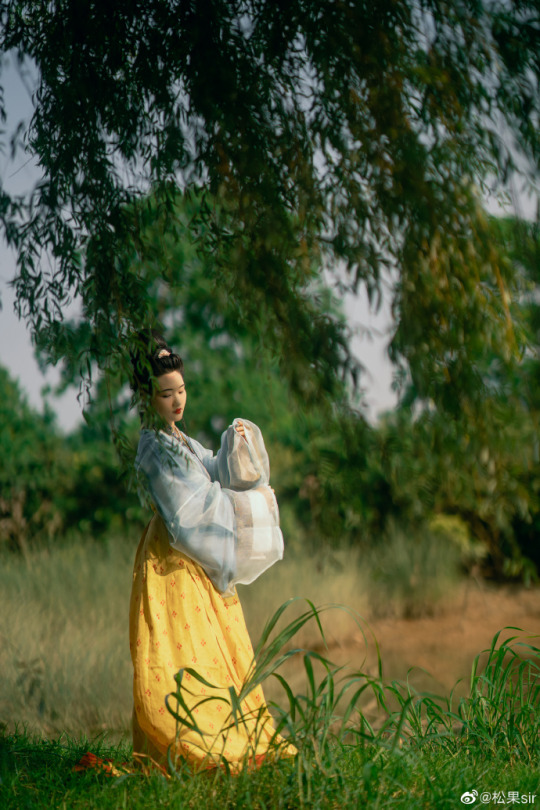
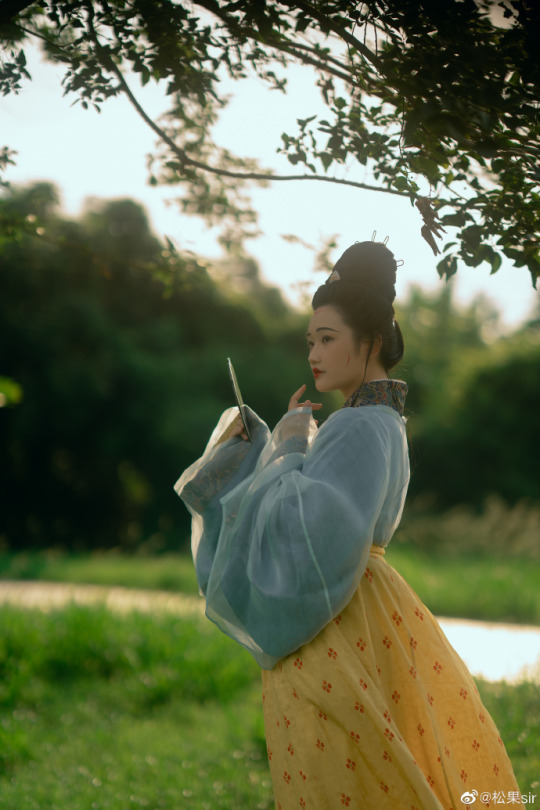

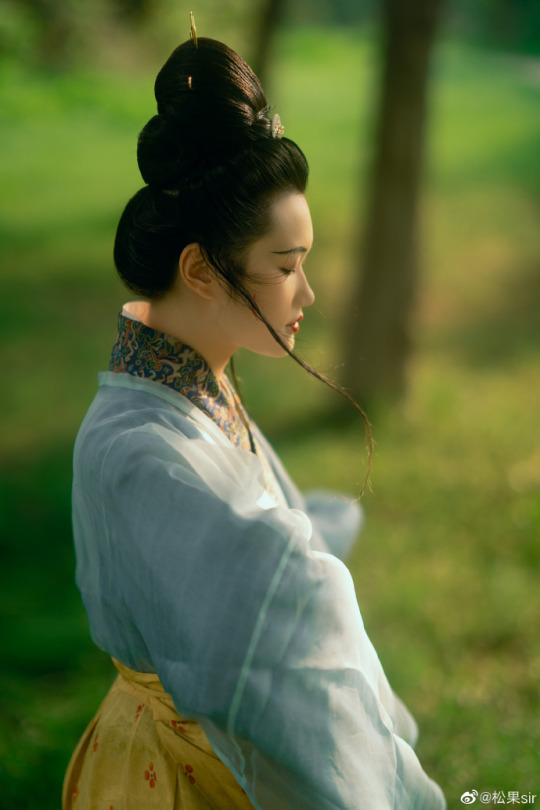


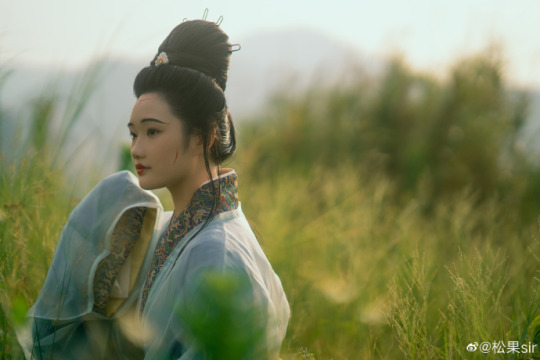
【Han Dynasty Historical Reference Artifacts】:
As early as the late Western Han Dynasty(206 BCE-25S CE), the High hair bun became popular, and it was no longer limited to the low hairstyle like early Western Han Dynasty (put the hair down and tied behind the back). Moreover, high hair bun it has been popular until the Eastern Han Dynasty(25–220) and Wei & Jin Dynasty.
According to the "Ballad in the City《城中谣》" of the Han Dynasty:
城中好高髻,四方高一尺。
城中好广眉,四方且半额。
城中好大袖,四方全匹帛。
【Translate】
High buns are popular in the city, and people all over the world have buns that are one foot taller.
Wide eyebrow are popular in the city, and people in the world draw(eyebrow) half their foreheads.
Big sleeves are popular in the city, and people all over the world use whole pieces of cloth to make them.
※" Ballad in the City 《城中谣》" is a folk song in "Yuefu Poetry Collection Miscellaneous Songs and Ballads《乐府诗集·杂歌谣辞》". On the surface, it talks about the fashion and its variation in the Han Dynasty, but actually satirizes the social atmosphere of blindly following the trend at that time.
---------
In addition, There were also changes in the way of dressing in the Western Han Dynasty and Eastern Han Dynasty Period.
Left:Murals of the Eastern Han Dynasty from Dahuting Han tombs
Right: female pottery figurines of the Western Han Dynasty (presumably early Western Han Dynasty)
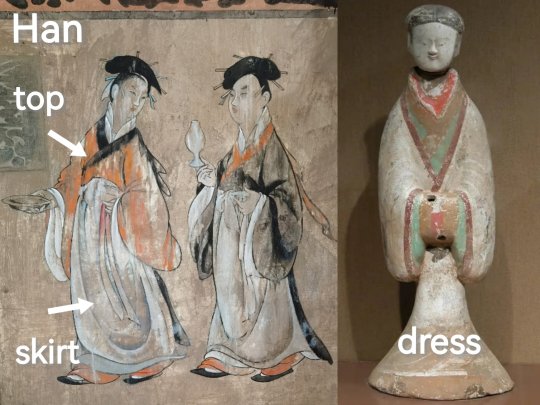
------------
Western Han Dynasty Mural Tomb unearthed from Xi'an University of Technology↓


Western Han Dynasty Mural,Unearthed from Cuizhuyuan Tomb No lin Qujiang New District of Xi'an, Shaanxi, in 2008
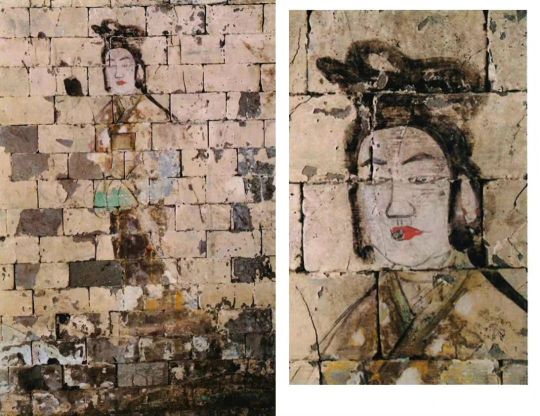
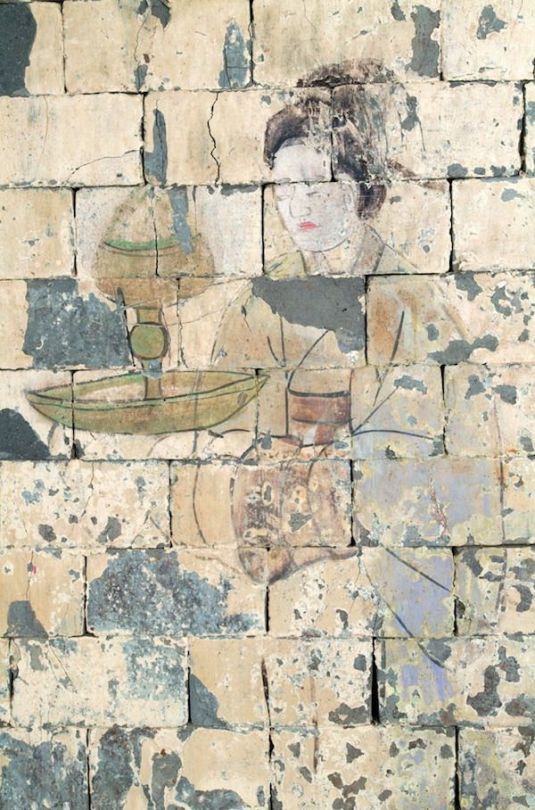
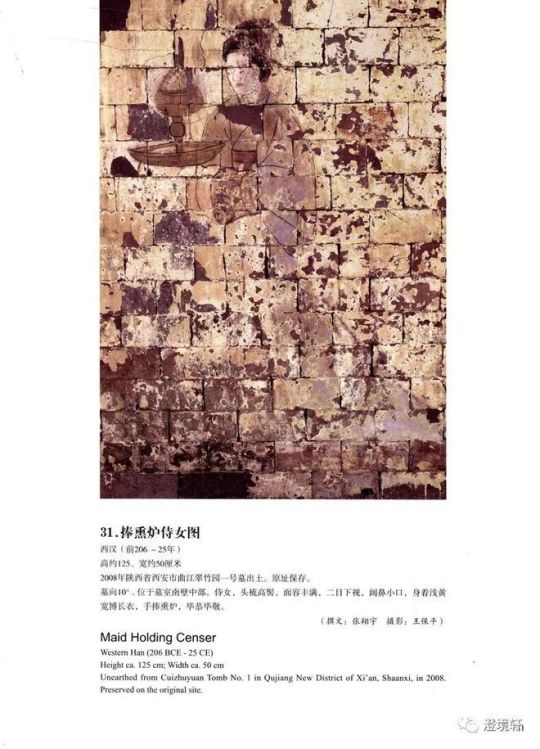
Western Han Dynasty Murals, Luoyang Museum Collection
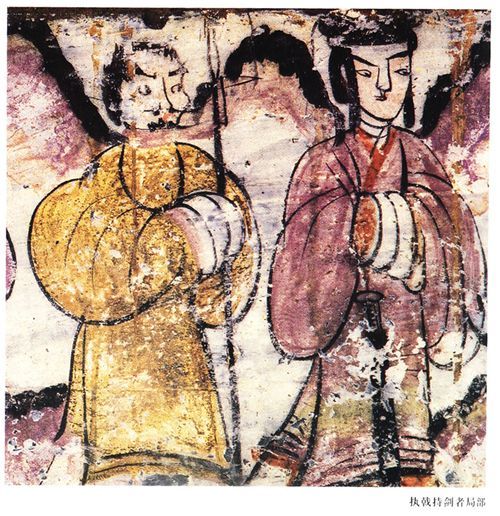
Eastern Han Dynasty Mural in Lujiazhuang, Anping County/安平县逯家庄东汉壁画墓
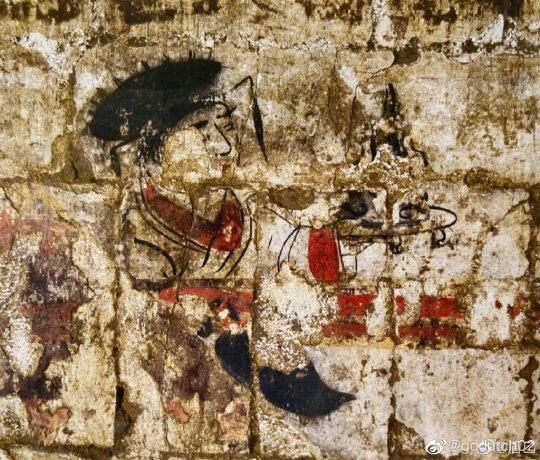
[Hanfu · 漢服]Chinese Eastern Han Dynasty (25–220 A.D.) Traditional Clothing Hanfu Photoshoot
_______
📸Photo:@松果sir
👗Hanfu:@桑纈
📍Filming Location: Minhou, Fuzhou,China
🔗Weibo:https://weibo.com/3250619702/N4GoJiBmz
_______
#chinese hanfu#Eastern Han Dynasty (25–220 A.D.)#western han dynasty#chinese history#chinese traditional clothing#hanfu history#chinese archeology#chinese#chinese historical fashion#hanfu#hanfu photoshoot#China History#hanfu accessories#hanfu artifacts#漢服#汉服#松果sir#桑纈
176 notes
·
View notes
Photo



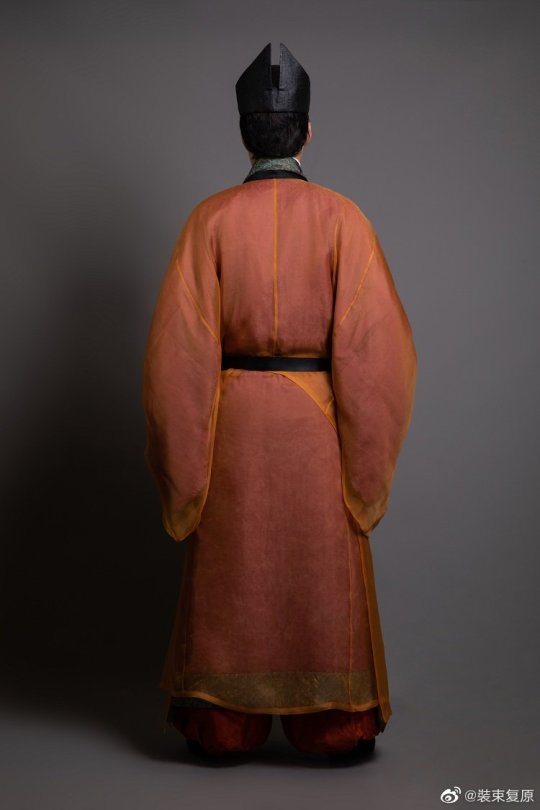
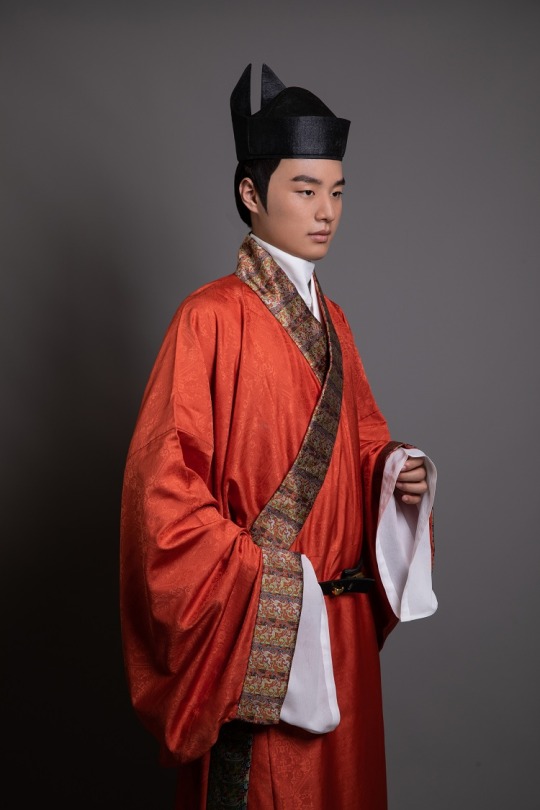
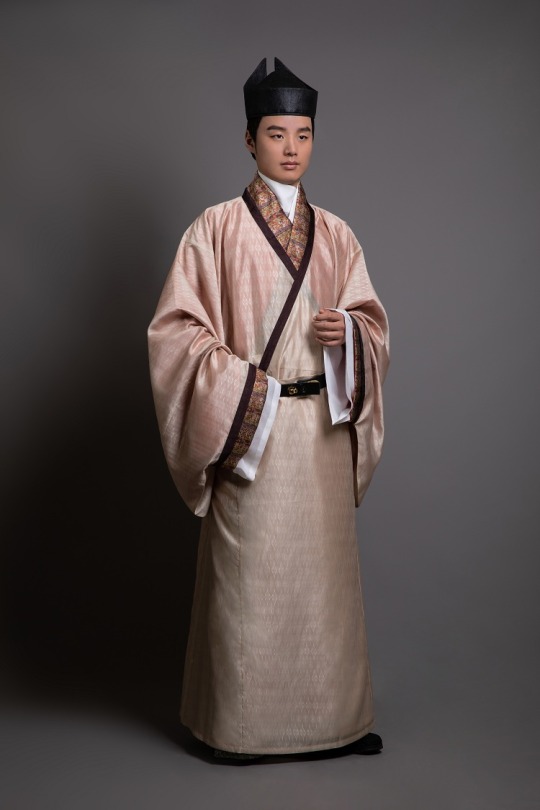
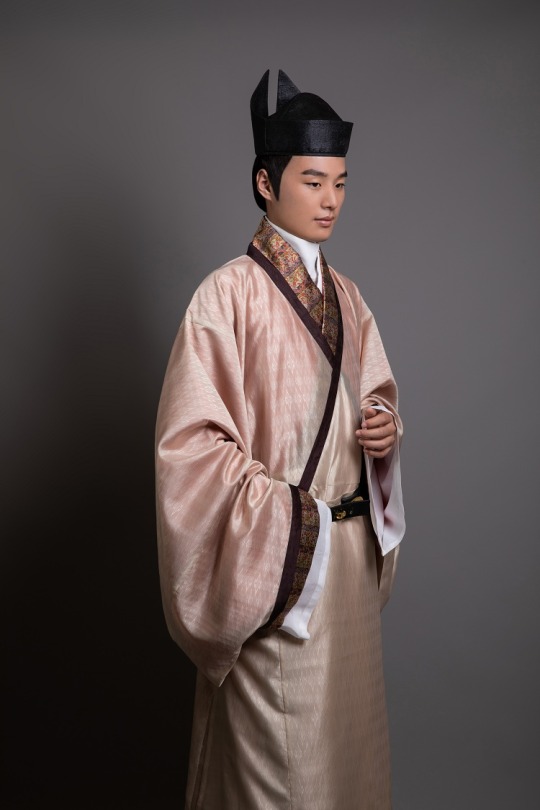
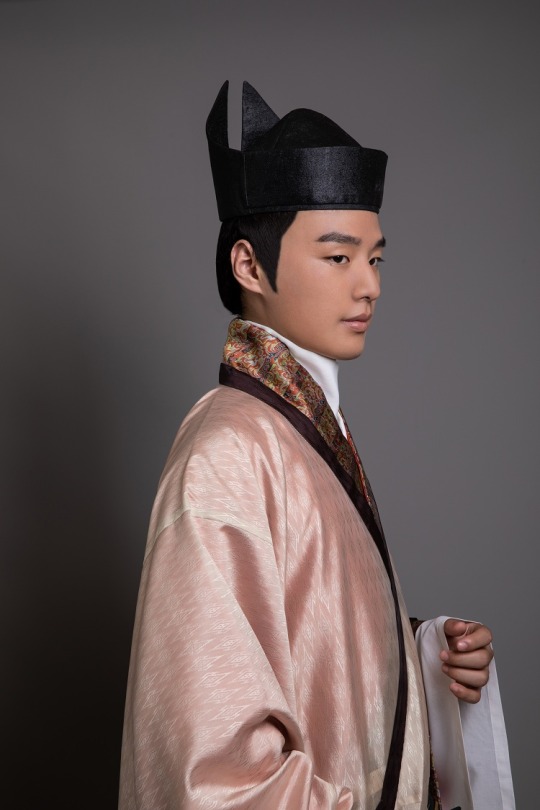


【Historical Artifacts Reference 】:
China Eastern Han Dynasty Playing Qin Pottery Figurine
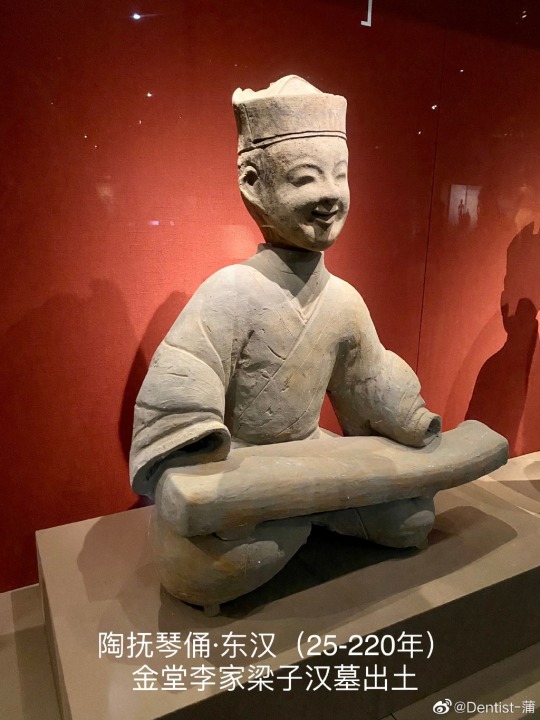
China Eastern Han Dynasty Playing the Dizi(Chinese flute) Pottery Figurine
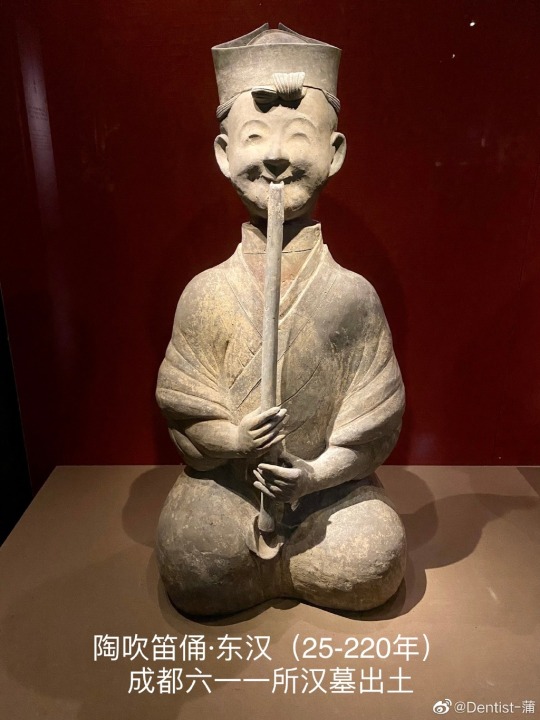
China Wei and Jin Dynasties "person who conveys official documents and letters" Mural Bricks
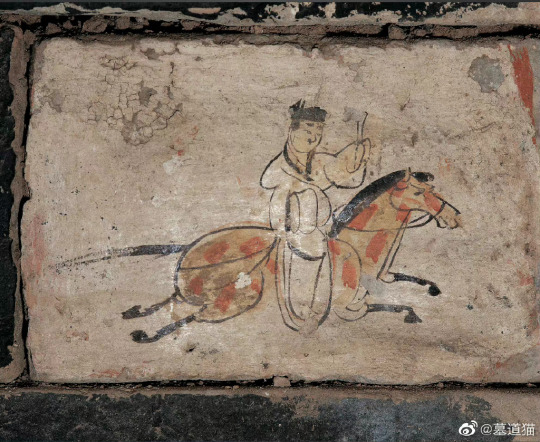
[Hanfu・漢服]Chinese Eastern Han Dynasty (25–220 A.D.) Traditional Clothing Hanfu & Headwear
—–
【History Note】
During the Eastern Han Dynasty, men's attire was usually wider than the Western Han Dynasty period, which was more convenient for activities.The collocation of wearing Jie Zhi(介帻) and straight train robes(直裾袍服) is favored by scholars at the time.
This set of attire for the scholars/literati of the Eastern Han Dynasty is wearing a Jie Zhi /介帻 on head, with a purple brocade border cotton robe, red silk cotton trousers, waering a yellow gauze on the outermost layer, and a brocade pouch around the waist.
At the time, the fashion of wearing gauze robe was still popular, which looked elegant and dignified, without losing the beauty of agility and elegance.
This set of attire has existed among the literati until the Wei and Jin Dynasties.
————————
📝Recreation Work : @裝束复原
👗 Hanfu: @桑纈
🔗Weibo:https://weibo.com/1656910125/MdvaOoRei
————————
#Chinese Hanfu#Eastern Han Dynasty (25–220 A.D.)#hanfu#hanfu history#hanfu accessories#chinese traditional clothing#chinese historical fashion#chinese history#Chinese Costume#chinese costume history#Chinese Culture#artifacts#Wei and Jin Dynasties#裝束复原#桑纈#漢服#汉服#Jie Zhi(介帻)#直裾袍服
131 notes
·
View notes
Photo



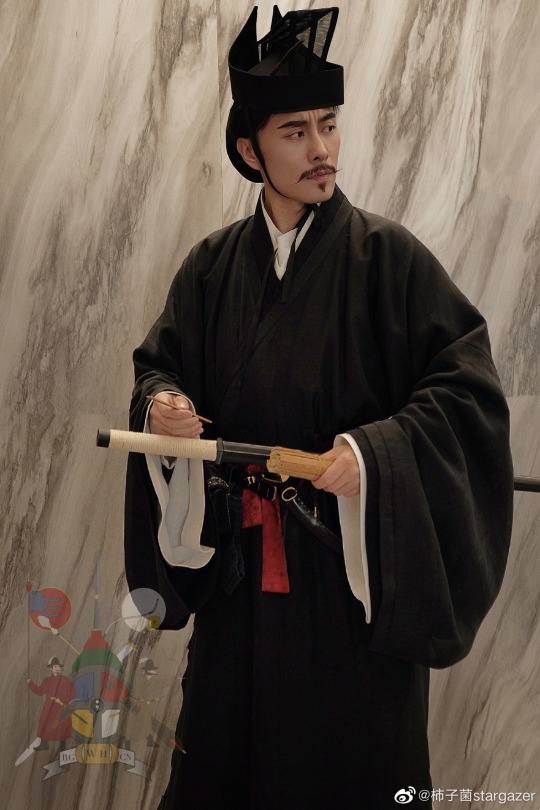






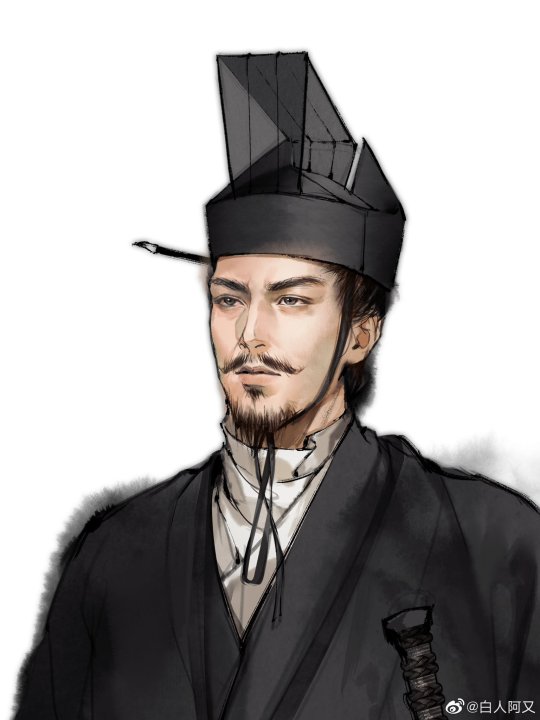
【Reference Artifacts】
Chinese Western Han Dynasty-Eastern Han Dynasty(202 BC – 9 AD, 25–220 AD) Murals and Stone Carvings
the court dress of Civil Officials during the Eastern Han(25-220)dynasty.



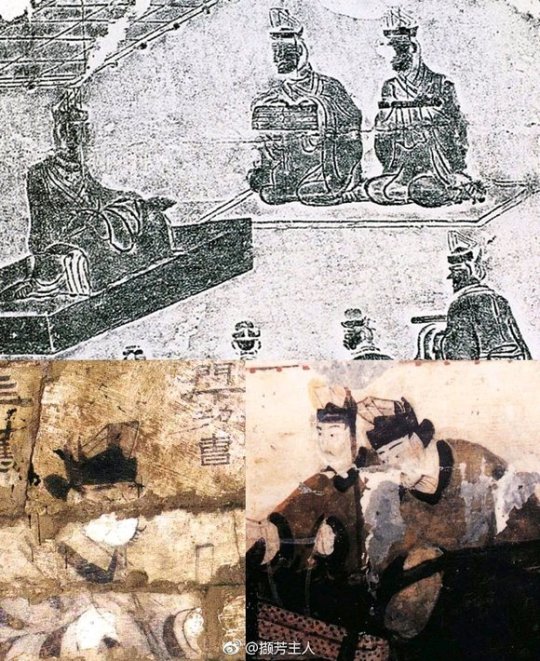
[Hanfu · 漢服]Chinese Eastern Han Dynasty (25–220 A.D.) Hanfu-Civil Officials Based On Han Dynasty Relics
【History Note】
In the Eastern Han Dynasty, officials were divided into civil officials(文官) and military officials (武官),and civil officials usually wore black robes and a cloth crown called "Jinxian Crown/進賢冠" on their heads.
The military officer (武官) is different from the civilian officer. They wear red robes and wear a crown call” Wubian DaGuan/Huben crown(武弁大冠 or 虎贲冠)”,These crown is characterized by always having two feathers on it
Refer to the picture below to distinguish between civil officials and military officials in the Eastern Han Dynasty
pic from Romance of the Three Kingdoms (TV series in 1994)
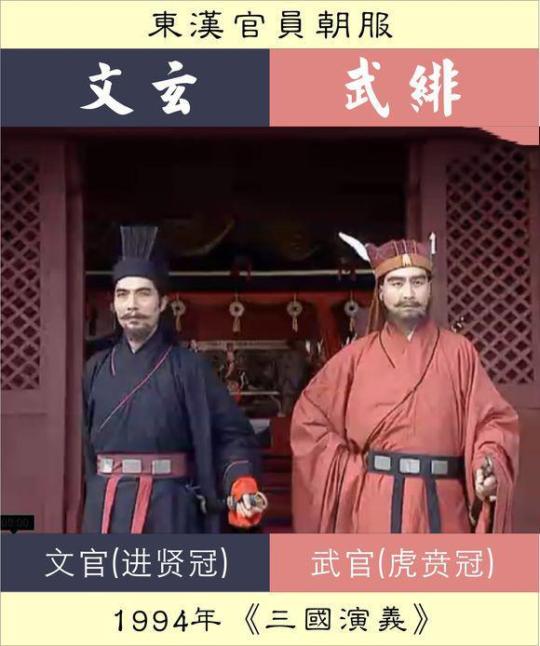
During the Three Kingdoms period(220–280 AD) in China (the end of the Eastern Han Dynasty), Zhuge Liang(諸葛亮), a well-known Chinese military engineer, strategist, statesman, and writer should wear the above civil official clothes when meet the emperor instead of wearing the clothes like below:

・↑Portrait of Zhuge Liang in the China Ming Dynasty(1368-1644 AD).

・↑The image of Zhuge Liang produced by a Japanese game company
----
The above image is the image of Zhuge Liang imagined by later generations combine with the actual costumes at the Song Dynasty(960–1279 AD) in China.
The Three Kingdoms game, including those made by the Japanese, is also based on the image of Zhuge Liang imagined and drawn by people after the Song Dynasty(960–1279 AD).
Which is not conform to the clothing that Zhuge Liang should have worn in Three Kingdoms period(220–280 AD,the end of the Eastern Han Dynasty)
________________
🙋♂️Model & Recreation Work:@柿子菌stargazer
📸Photo: @张宇莹-小花
🎨Painting Artist:@白人阿又
🔗Weibo:https://weibo.com/1812652835/N1w7AClHo & https://weibo.com/6137313995/Msbxt7ynG
________________
#chinese hanfu#Eastern Han Dynasty#Three Kingdoms period(220–280 AD)#Civil Officials#military officer#Zhuge Liang#Jinxian Crown/進賢冠#Wubian DaGuan/Huben crown(武弁大冠 or 虎贲冠)#皂緣中衣#皂禪衣#柿子菌stargazer#张宇莹-小花#白人阿又#hanfu#historical clothing#historical fashion#hanfu history#漢服#hanfu accessories#hanfu artifacts
311 notes
·
View notes
Text

Incense Burner (Xunlu or Xianglu)
China, Eastern Han dynasty (A.D. 25–220), 1st/2nd century A.D.
28 notes
·
View notes